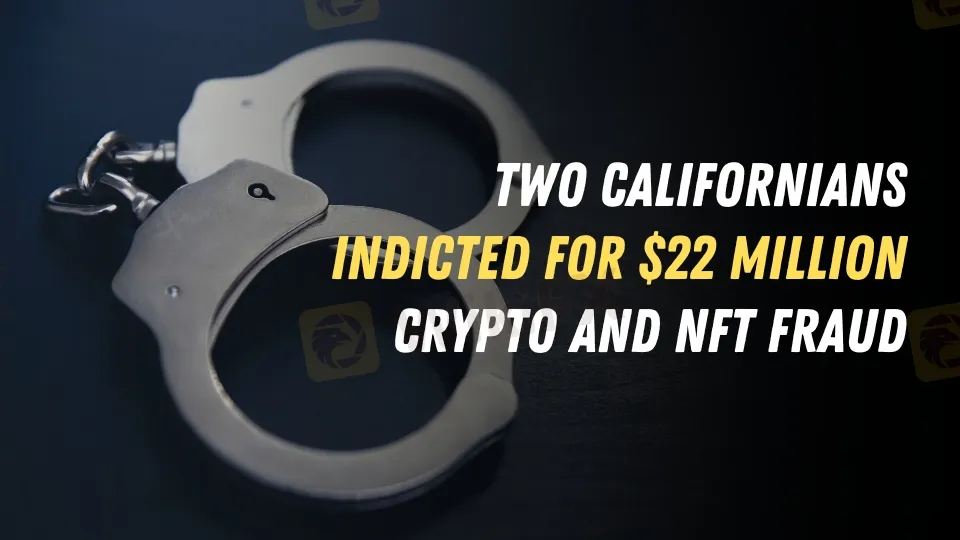简体中文
繁體中文
English
Pусский
日本語
ภาษาไทย
Tiếng Việt
Bahasa Indonesia
Español
हिन्दी
Filippiiniläinen
Français
Deutsch
Português
Türkçe
한국어
العربية
Two Californians Indicted for $22 Million Crypto and NFT Fraud
Sommario:Gabriel Hay & Gavin Mayo indicted for $22M crypto fraud. Learn about the Vault of Gems scam and how to avoid NFT rug pull schemes.

Authorities have indicted two Southern California men for allegedly defrauding investors out of over $22 million in cryptocurrency schemes. Gabriel Hay, 23, of Beverly Hills, and Gavin Mayo, 23, of Thousand Oaks, are accused of orchestrating a series of fraudulent projects involving nonfungible tokens (NFTs) and digital assets, according to federal prosecutors.
How the Alleged Crypto Scam Unfolded
Prosecutors allege that between May 2021 and May 2024, Hay and Mayo, along with an unnamed co-conspirator, operated multiple “rug pull” schemes. In these schemes, they collected substantial funds from investors before abandoning the projects, keeping the money for personal use.
One such project, Vault of Gems, was promoted as the first NFT “pegged to a hard asset.” The duo falsely claimed partnerships with jewelers and the development of an exclusive exchange for jewelry retailers. Despite their promises, the project was abandoned, leaving investors frustrated and defrauded.
Digital Assets and Fraudulent Activities
Cryptocurrency, a decentralized form of digital money, has gained immense popularity. Major cryptocurrencies like Bitcoin, Ethereum, and Solana offer investment opportunities, but they also attract scammers. NFTs, unique digital assets used as proof of ownership, have become a prime target for fraudsters.

Hay and Mayo allegedly used these digital tools to their advantage, transferring funds from their projects into personal wallets. Their fraudulent ventures included names like Faceless, Sinful Souls, Clout Coin, Dirty Dogs, Uncovered, MoonPortal, Squiggles, and Roost Coin.
Legal Actions and Charges
The U.S. Department of Justice is cracking down on such schemes. Principal Deputy Assistant Attorney General Nicole Argentieri stated, “Fraudsters take advantage of new technologies and financial products to steal investors hard-earned money.”
Hay and Mayo now face one count of conspiracy to commit wire fraud, two counts of wire fraud, and one count of stalking. If convicted, they could face up to 20 years in prison for each conspiracy and wire fraud charge, plus an additional five years for the stalking charge.
Harassment Allegations
In a separate charge, prosecutors allege that Hay and Mayo harassed a project manager who revealed their connection to fraudulent projects. The indictment claims they sent threatening messages to the manager and his family, posing as lawyers and investors. The threats escalated to false accusations and harassment through social media, demonstrating the lengths the accused went to silence whistleblowers.
Final Thoughts
The indictment of Gabriel Hay and Gavin Mayo serves as a stark reminder of the risks associated with cryptocurrency and NFT investments. While these digital assets hold great promise, they also provide a fertile ground for scams. Investors should conduct thorough research, verify the legitimacy of projects, and remain vigilant against red flags like unrealistic claims and lack of transparency.
As authorities crack down on fraudulent activities, the hope is that stricter enforcement and increased awareness will protect investors from similar schemes in the future.

Disclaimer:
Le opinioni di questo articolo rappresentano solo le opinioni personali dell’autore e non costituiscono consulenza in materia di investimenti per questa piattaforma. La piattaforma non garantisce l’accuratezza, la completezza e la tempestività delle informazioni relative all’articolo, né è responsabile delle perdite causate dall’uso o dall’affidamento delle informazioni relative all’articolo.
WikiFX Trader
WikiFX Trader
Rate Calc







